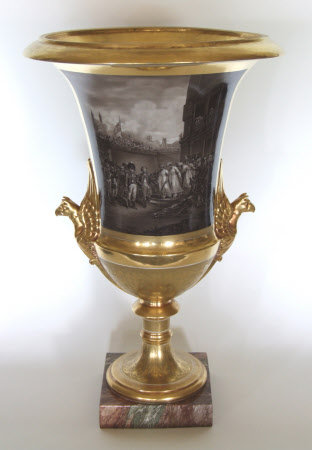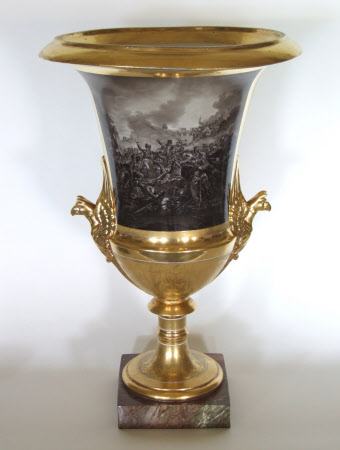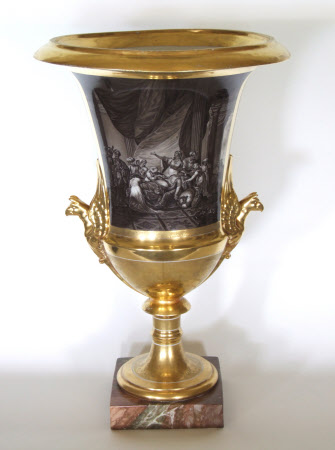Vase
Sèvres Porcelain Manufactory
Category
Ceramics
Date
1803 - 1820
Materials
Ceramic
Measurements
597 mm (Height); 390 mm (Diameter)
Place of origin
France
Order this imageCollection
Uppark House and Garden, West Sussex
NT 137405.2
Summary
"Tippoo Sahib” vase with the Seige of Seringapatam (Srirangapatna) 1799, one of a pair, hard-paste porcelain, of elongated Medici campana-type, with winged griffin head handles, covered with a burnished gold ground with etched details, each with two scenes painted in brown-black enamels or ‘en grisaille’, after engravings based on two imagined paintings by Henry Singleton (1766-1839): ‘The Storming of Seringapatam in 1799,’ by A. Cardon (1772–1813) and L. Schiavonetti (1765–1810); ‘The Last Effort and Fall of Tippoo Sultaun in 1799’, or ‘Vignette: Tippoo's Sons given to the English as Hostages’, by J. Rogers ‘The Body of Tippo Sultaun recognised by his Family, in 1799’, by L. Schiavonetti, c.1800; ‘The Surrender of Two Sons of Tippoo Sultaun, in 1799’ by J. Rogers, raised on faux marble painted porcelain plinth, possibly Paris, c.1803-1820, signed ‘Halbedel’. In 1863, The Siege of Seringapatam; or, the Maiden of Mesopotamia. A hippodramatic spectacle in three scenes & one grand act, was written and performed in London specially for a fête given in aid of the funds of the Hospital for Incurables. The vases may have entered the collection during the time of Admiral the Hon. Sir Herbert Meade-Fetherstonhaugh (1875-1930). His grandfather Richard Meade, 3rd Earl of Clanwilliam (1795-1879) had been a diplomat in the Foreign Service from 1817 to 1823, with an Embassy to Berlin, Germany 1823-27. One of a pair of Napoleonic Sèvres First Empire large vases, Medicis, of slender campauna form, with winged gilt griffin head handles, the panels painted in grisaille with scenes from the life and death of the Indian prince Tippoo Sahib, (1749 to 1799) on gold grounds, with marble bases. (NT/UPP/C/3a is other in pair).
Marks and inscriptions
Halbedel (pinx) (inscribed under panels)
Makers and roles
Sèvres Porcelain Manufactory , maker Halbedel, artist



